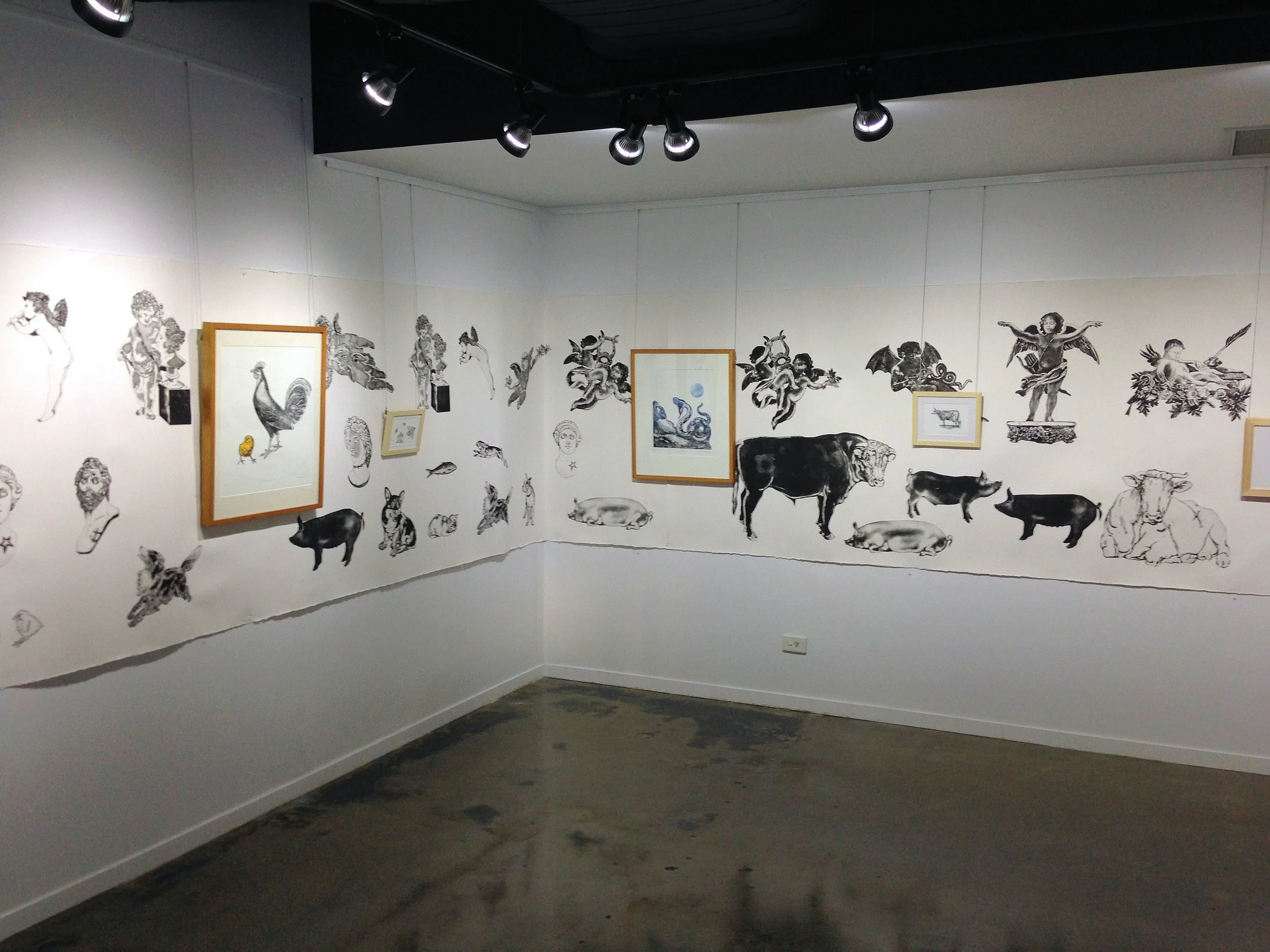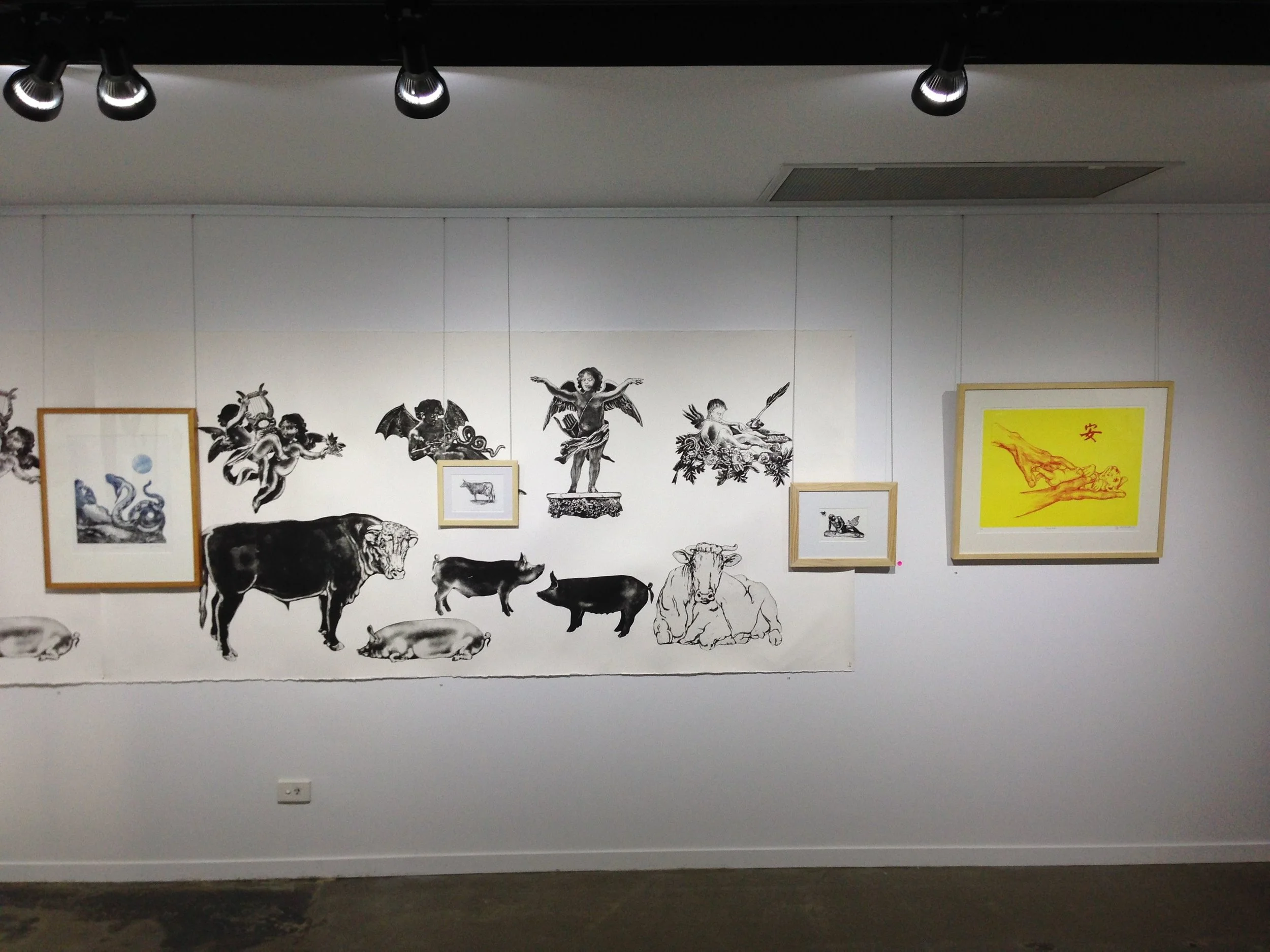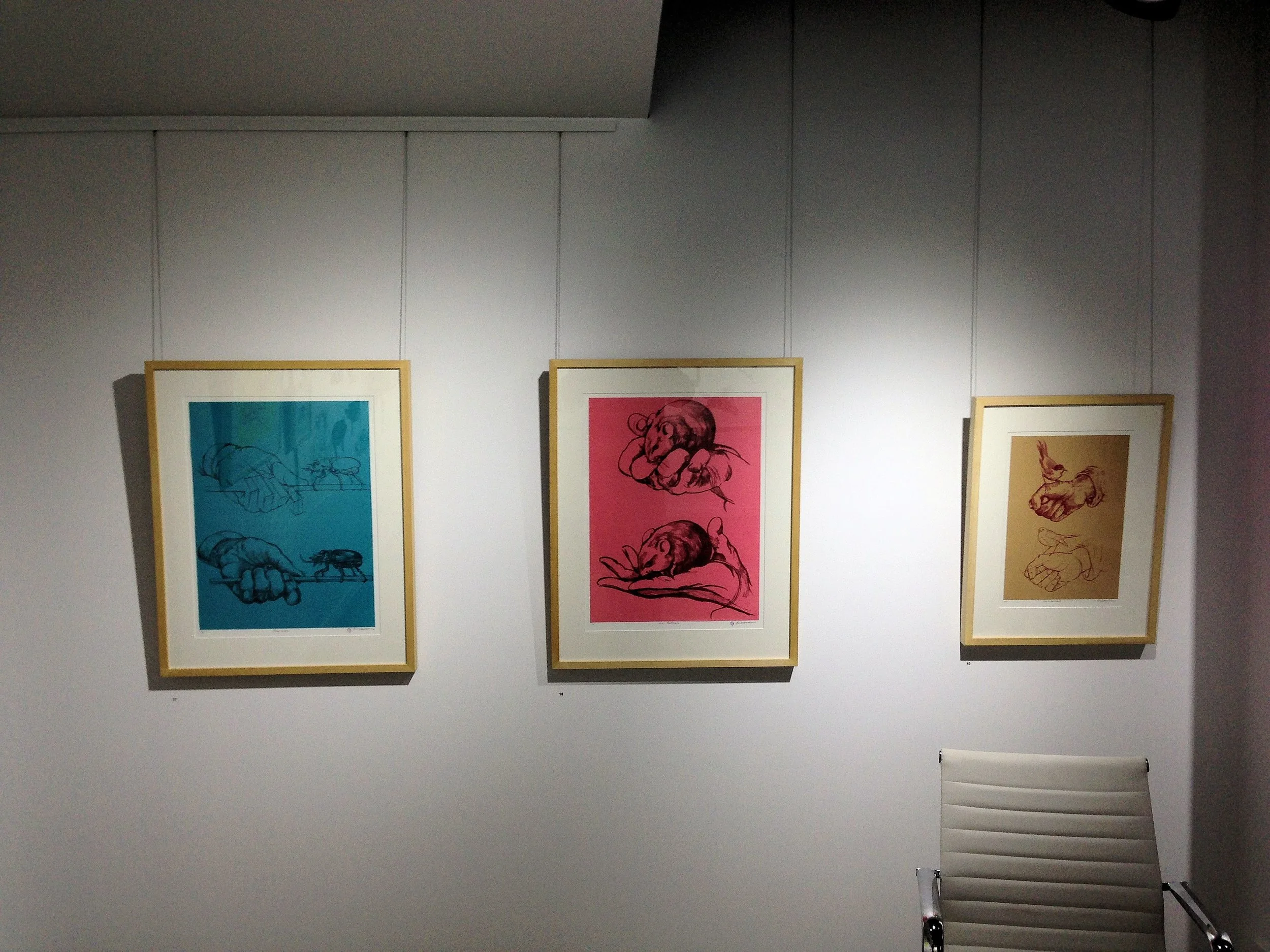Exhibition Tattoo Salon
Installation view
Since the 1990s there have been global attempts to incorporate the tattoo artist’s craft into the art world with exhibitions in major galleries and even the Venice Biennale. The Australia artist Ex de Medici has also managed to cross the popular culture and high art divide with representation in biennial surveys and the national and state collections.
This exhibition titled “Tattoo Salon” takes a more critical perspective on the narrow vocabulary of images used in the majority of contemporary tattoo shops or parlours. Almost all the images displayed around the walls of the gallery in this exhibition were sourced from European drawing manuals and associated high art sources. These were then selectively reconfigured in framed “wall tattoos”. Foregrounding the graphic motifs, that were considered the foundational visual vocabulary of European picture making for the past century, as potential tattoo designs creates a perplexing engagement since hardly any of these match the most common or popular contemporary designs that seem to have little basic in cultural or lived experience. The exhibition impact implies that the contemporary notion of using the body as a “canvas” is perceptually, mechanically and culturally a highly problematic proposition or practice.
Catalogue (external fold)
Installtion view. background shaped copper plate etchings with aquatint. Framed works etching and aquatint with laser cut relief print.
Tattoo Salon by Ross Woodrow
13 August – 7 Sept 2014 Bosz Gallery, 4/9 Doggett St Fortitude Valley, Brisbane Australia (Bosz Gallery opened in 2014, this was the opening exhibition, and closed in 2017)
Ross Woodrow Heritage etching and aquatint c.50 x 80 cm.
Catalogue Essay
Tattoo Salon
The universality of tattooing is a curious subject for speculation.
—James Cook, 1779
And this tattooing had been the work of a departed prophet and seer of his island, who, by those hieroglyphic marks, had written out on his body a complete theory of the heavens and the earth, and a mystical treatise on the art of attaining truth; so that Queequeg in his own proper person was a riddle to unfold; a wondrous work in one volume; but whose mysteries not even himself could read, though his own live heart beat against them; and these mysteries were therefore destined in the end to moulder away with the living parchment whereon they were inscribed, and so be unsolved to the last.
—Herman Melville, Moby-Dick, 1851
There’s a myth that the art of tattooing didn’t become popular in Europe until Captain Cook returned from his voyages to the southern hemisphere in the late 1700s. The term was reconstructed from the Polynesian word ‘tatau’ or the Tahitian word ‘tatu’ in the eighteenth century, although there is plenty of evidence that the practice, which had previously been referred to by a range of descriptive terms, from ‘pricking’ to ‘painting’, was well known in Europe before the far more exotic association of the word ‘tattoo’ was adopted.
In the southern hemisphere, the practice was closely associated with cultural rituals that linked the individual body to that of the tribe and to the places and knowledge of which they were custodians. The tattoo was a record of lineage, of linkage, of codes of conduct, of relationships, and of affiliations and responsibilities. It was a document marking out a pattern of connection that linked the largest organ of the body—the skin—to a blueprint of belonging to a caste, country, community, cosmology or custodianship responsibilities.
Conversely, in Europe, the practice was a far more individualised endeavour. Sailors, those workmen tainted with differences brought on by travel and employment typically identified with criminals on the run, were most often associated with the practice of inking embellishments that were personal markers of the outcomes and experiences of their choice to sail close enough to the shoreline to enjoy its benefits, but just far enough way to beat a hasty retreat. These emblems are all-too-familiar even today; the skull-and-cross-bones, the ship with sails a-billow, the sweet girls of the harbour ports have re-emerged as icons of daring and difference in an era where the Earth’s maps have been re-charted by the cartographic flattening of Google Earth, and where journeys of derring-do seem like a horizon all-the-more-far-away. To thevtattoo-choosers of the early-twenty-first century, the icons of the old sailors’ tattoos seem like emblems of a more wond’rous past; symbols of a time when individual identity was something that was earned through experience rather than purchased as a label or token.
Ishmael, the protagonist of Herman Melville’s 1851 novel Moby-Dick, has emerged as literature’s sailor-prophet par excellence—a man whose chosen critical distance from his own society enables him to reflect on and describe both the folly of vanity and the incommensurable immensity of life. And through Ishmael’s improbable but close relationship with Queequeg, the exotic tattooed head-hunter-turned-harpoonist of mountainman proportions, Melville is able to allude to how the entire moral, ethical, cultural, and economic underpinning of European cultural values were ‘sent to sea’ once confronted with the enormity of ‘Otherness’ represented in Queequeg’s tattooed body. Queequeg’s markings are described as “a riddle to unfold”; his physical hieroglyphs appeared as a “mystical treatise on the art of attaining truth” that not even he could decipher. His tattoos, depicting a complex astrological system, are a symbol of the ineffable mystery that lies at the centre of Melville’s writing; codes that can’t be cracked, mysteries that can’t be fathomed, istances that can’t be plummeted flow through the pages like the sea itself. And Ishmael’s own tattoos were a mark that testified to his difference from the average nineteenth-century white man.
…
So what might it mean that Ross Woodrow has titled this exhibition of his prints Tattoo Salon? This artist is well aware of the roles that history and site play in establishing the resonance of art production. His location of Australia sits at cross-currents between the European imaginary and the Asia-Pacific re-imagining. Like Ishmael, the artist interested in issues of identity must maintain both a healthy scepticism as well as an openness to both claims to authority and authenticity.
Australia’s non-indigenous denizens are the necessarily sceptical heirs of European culture and codes. Like Ishmael, they cling to the flotsam and jetsam of their inherited culture, while other cultures and codes, only partly understood, roll and roil around them. And while they have continued their efforts to reimagine identity as part of an emerging Asia-Pacific identity, Australians are wise to be mindful of the ill-fitting awkwardness of their presence in the region.
In this exhibition, icons of European codes of culture and agriculture—animals and angels—are scattered across the gallery walls in what appear to be random juxtapositions. The images the artist employs are diverse in scale and representation: from cut-out copper plates, he has assembled a bestiary and an anthology of cherubim; in other prints, he assembles a roll call of data gathered from nineteenth-century wood and steel plate engravings offering instructions from the pages of ‘how-to-draw’ manuals. The imagery floats across wall-paper-like lengths of Hahnemühle paper that resemble, the artist describes, “tattoos across the gallery wall”.
And if Woodrow’s long-term interest in the historical archive is evident in this exhibition (all of the image references have been gathered from his personal library of old books and reinterpreted into a range of different print forms), his ongoing interest in the marginal, the kitsch, and a predilection for irony and critical self-reflection are also apparent. The artist’s adoption of images from instructional manuals transparently reflects his other role as an art educator, the abundant ironies of which he charts with a keen eye on critical currents. In this exhibition, the range of ‘how-to-draw’ styles and approaches are scattered like mix-and-match options without hierarchy or authority; to the historically or culturally uneducated, they simply exist as non-specific referents amid a history-free present. Where once such images stood for cultural correctness or graphic accuracy or classical form or as indicators of the superiority of Western culture (and agriculture), they now appear as scattered symbols, infinitely reproducible ciphers from the past.
Woodrow adopts the title for his exhibition in the same spirit of self-awareness; for his generation, tattoos still represented bodily markers of cultural ‘Otherness’—as self-chosen indicators of identity that were capable of either magnifying or contradicting physiognomy. However, he is well aware that for Gen X- and Y-ers, tattoos have become pick-and-pay emblems of belonging, a form of ‘self-expression’ that cuts across codes and differences. Today, according to the National Health and Medical Research Council, one in seven Australians sport tattoos, with 40 percent getting their first tattoo aged twenty-six or older, and a surprising one in ten Australians getting their first tattoo aged in their mid-forties or older.
However, unlike the interconnected references of the mysterious cosmology represented on Queequeg’s body, the images chosen for these twenty-first-century tattoos are interchangeable. Woodrow’s work echoes the floating nonspecificity of this use of imagery. Lacking any specific contextual attachment, they are ciphers from compendia and taxonomies of former eras where the imposition of shared beliefs of patterns of connectedness held sway. Woodrow’s cherubim are avatars of romantic idealism and classical training; they are the chubby decor left over when a shared belief in cosmological order is evacuated. His bestiary is composed largely of the domesticated animals on which European civilisation was founded, and the subjects of his individual prints are frequently images where the specificity of historical imagery has been overlaid by clues that offer more ironic readings.
In Moby-Dick, Queequeg seems unperturbed by the fact that the meaning of the symbols that cover his body has been lost to him. The author of the work, a wise man from his former tribe, died without recounting the clues to its interpretation, which means that Queequeg will never decipher the code to his own body’s expressive cartography. However, in a final act that belies the depth of the importance the character heeds to these mysterious symbols, Queequeg begins the meticulous process of carving his own coffin with the details of his bodily markings.
If Woodrow is well aware of the fact that in today’s world, the images he uses are accepted as mere floating signifiers, stripped of their historical understanding, torn from the contextual mesh-work of their meaning, he is also acutely aware of the dense weight of each of their cultural origins. As an art historian, Woodrow is conscious that much is lost when symbols are ripped from their cultural ballast and used with illiterate abundance. And while he is cognisant that today’s tattoos do little to anchor the body of the wearer into a deeply understood cultural, historical, and cosmological framework, he is also mindful that such images can bear rich harvests of cultural understanding, capable of unlocking a great deal of what lies just beneath the surface of the cultural skin that wraps around each of us.
Professor Pat Hoffie, August 2014
Installation view.
Installation view
Installation views three lithographs.
Installation view, shaped plate etchings with aquatint and etching on zinc.
Copyright © Ross Woodrow --All Rights Reserved









